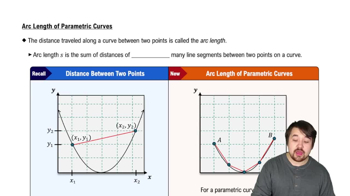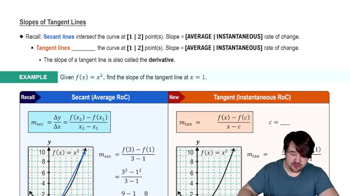Explain the steps required to find the length of a curve x = g(y) between y=c and y=d.
Table of contents
- 0. Functions7h 54m
- Introduction to Functions16m
- Piecewise Functions10m
- Properties of Functions9m
- Common Functions1h 8m
- Transformations5m
- Combining Functions27m
- Exponent rules32m
- Exponential Functions28m
- Logarithmic Functions24m
- Properties of Logarithms36m
- Exponential & Logarithmic Equations35m
- Introduction to Trigonometric Functions38m
- Graphs of Trigonometric Functions44m
- Trigonometric Identities47m
- Inverse Trigonometric Functions48m
- 1. Limits and Continuity2h 2m
- 2. Intro to Derivatives1h 33m
- 3. Techniques of Differentiation3h 18m
- 4. Applications of Derivatives2h 38m
- 5. Graphical Applications of Derivatives6h 2m
- 6. Derivatives of Inverse, Exponential, & Logarithmic Functions2h 37m
- 7. Antiderivatives & Indefinite Integrals1h 26m
- 8. Definite Integrals4h 44m
- 9. Graphical Applications of Integrals2h 27m
- 10. Physics Applications of Integrals 3h 16m
- 11. Integrals of Inverse, Exponential, & Logarithmic Functions2h 34m
- 12. Techniques of Integration7h 41m
- 13. Intro to Differential Equations2h 55m
- 14. Sequences & Series5h 36m
- 15. Power Series2h 19m
- 16. Parametric Equations & Polar Coordinates7h 58m
9. Graphical Applications of Integrals
Introduction to Volume & Disk Method
Problem 6.5.7
Textbook Question
Find the arc length of the line y = 2x+1 on [1, 5] using calculus and verify your answer using geometry.
 Verified step by step guidance
Verified step by step guidance1
Recall the formula for the arc length of a curve defined by a function \(y = f(x)\) on the interval \([a, b]\):
\[L = \int_a^b \sqrt{1 + \left(\frac{dy}{dx}\right)^2} \, dx\]
Identify the function and interval: here, \(y = 2x + 1\) and the interval is \([1, 5]\).
Compute the derivative \(\frac{dy}{dx}\): since \(y = 2x + 1\), then
\[\frac{dy}{dx} = 2\]
Substitute \(\frac{dy}{dx}\) into the arc length formula:
\[L = \int_1^5 \sqrt{1 + (2)^2} \, dx = \int_1^5 \sqrt{1 + 4} \, dx = \int_1^5 \sqrt{5} \, dx\]
Since \(\sqrt{5}\) is constant, the integral simplifies to
\[L = \sqrt{5} \int_1^5 dx\]
Evaluate the integral and interpret the result geometrically:
The integral \(\int_1^5 dx\) equals \((5 - 1) = 4\), so
\[L = 4 \sqrt{5}\]
To verify geometrically, recognize that \(y = 2x + 1\) is a straight line segment between points \((1, 3)\) and \((5, 11)\). Use the distance formula
\[d = \sqrt{(x_2 - x_1)^2 + (y_2 - y_1)^2}\]
Calculate this distance and confirm it matches the arc length found via calculus.
 Verified video answer for a similar problem:
Verified video answer for a similar problem:This video solution was recommended by our tutors as helpful for the problem above
Video duration:
4mPlay a video:
Was this helpful?
Key Concepts
Here are the essential concepts you must grasp in order to answer the question correctly.
Arc Length Formula
The arc length of a curve y = f(x) from x = a to x = b is found using the integral formula L = ∫_a^b √(1 + (dy/dx)^2) dx. This formula calculates the length of the curve by summing infinitesimal line segments along the curve.
Recommended video:

Arc Length of Parametric Curves
Derivative of a Function
The derivative dy/dx represents the slope of the function y = f(x) at any point x. For the line y = 2x + 1, the derivative is constant, which simplifies the arc length calculation since the slope does not change over the interval.
Recommended video:

Derivatives of Other Trig Functions
Geometric Interpretation of Line Segment Length
The length of a straight line segment between two points (x1, y1) and (x2, y2) can be found using the distance formula √((x2 - x1)^2 + (y2 - y1)^2). This provides a geometric verification of the arc length calculated via calculus for linear functions.
Recommended video:

Slopes of Tangent Lines

 5:38m
5:38mWatch next
Master Introduction to Cross Sections with a bite sized video explanation from Patrick
Start learningRelated Videos
Related Practice
Textbook Question
16
views
